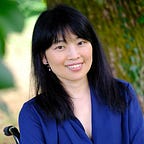My Little Prince Moments
“……..I am touched, intrigued and inspired by the thoughtful presentation you recorded (for the conference). It is a beautiful creation that speaks to the depth of your inquiry and capacity to connect with others. Thank you for sharing ‘yourself’ with us. Keiko,” wrote Daphne, a beautiful, accomplished artist-scientist of Métis heritage whom I met at the biennial conference of the Canadian Network for Arts and Learning (CNAL).
As I started reading the message on my iphone, I froze in exaltation and could not stop smiling. Tears filled my eyes. I was not sure whether it was because of the validation she gave me, or perhaps a sense of deep connection with something bigger than myself. “She sees what I see!” I silently exclaimed. But why was this so powerful?
The story I had created and submitted to the CNAL conference was not a particularly important one, in the context of the theme of the conference — the vital role that the arts play in the health and society. It wasn’t “most liked” by the diverse delegates from around the world. But it was meaningful to me, as it illustrated (albeit clumsily) the why and the how of my current mission and passion.
Shortly after the conference, I happened to listen to an audio book of The Little Prince, by Antoine de Saint-Exupéry, one of my favorite books. Every time I read or listened, I experienced different emotional reactions and new revelations. This time, I was intrigued and puzzled by an exchange between the Little Prince and the snake:
The Little Prince asks the snake, “But why do you always speak in riddles?”, to which the snake responds with another indirect answer: “I solve them all”.
Huh? I knew the snake represented death, but at first could not understand what this dialogue really meant. Who is “I” really? What is the symbolism of “riddles”? Why did the snake answer the way he did?
After some thought, I arrived at this interpretation: The Little Prince asks the snake, “But why do you act childlike?” I took this to mean “Why do you remain an artist as you grow up?” The snake answers, “When you face your own imminent death, you will understand everything.” This, then, explains how the snake solves riddles. And it explained something important about my own life.
For a long time, I believed that I should look outwardly to the world and follow the career in public health and epidemiology that I had pursued for 12 years. Unfortunately, due to the lengthy educational process and competitive environment, I had begun to think along narrow lines. I only cared about my work, survival, productivity, and status, and made no time for other people. I judged my worth by the number of publications in first-tier journals. Just like the different types of adults whose frivolities and weaknesses are revealed in The Little Prince, I had lost my inner child somewhere.
Then, after experiencing an illness that took me to the very edge of death, I started seeing the world with my heart. It is no coincidence that I remember almost everything about my immediate post-near-death existence: so many challenging but beautiful moments and unforgettable friends and kind strangers. These are my lifetime treasures and sources of unlimited love. My father-in-law told me, over the phone, “As long as Maya (my baby daughter) has a mother, that is all that matters.” He was right. I am worthy just because I exist. I was freed from the fear of “publish or perish.” I was overjoyed to be alive. Instead of returning to Columbia University, where I had been working, I commuted, with my daughter, every day for two years to a nearby playground in Hell’s Kitchen, in Manhattan. There I met all sorts of artist parents who became my lifetime friends. In the playground, all the toddlers and children were my teachers and showed me how to be an artist. They did not see my wheelchair as a mark of something wrong, but rather thought that I had come with a cool toy. We played and bonded together all day, in all seasons. I still sometimes wonder how all those kids are doing. I thank them for sharing their world with me. What is truly valuable in life? Time.
I gradually began to realize how little I knew about the community I lived in, my heritage, and myself. After I left New York and settled in Vancouver, Canada, spontaneous discoveries began to flood my life and fill my whole heart. My Vancouver friends and colleagues keep reminding me that we are all artists. What if we could all keep and nurture our childlike thinking and sense of discovery? Could we possibly solve all mysteries and problems? In our own unique, individual lives, how can we — even if only temporarily — move from institutions of meritocracy and social control to institutions of co-creation and freedom?
My experience at the CNAL conference opened up a dream for me — a dream of living parts of our professional and personal lives in a playground — a mental and social space we all long for. As the Little Prince says, “Grown-ups never understand anything by themselves, and it is tiresome for children to be always and forever explaining things to them.” We adults often miss the important messages.
I still feel connected to Daphne by her words, as if we shared the same imagination, as if she deduced the meaning of my rudimentary drawing, like “Drawing Number One” in The Little Prince. This, for me, was intensely beautiful and full of promise.
